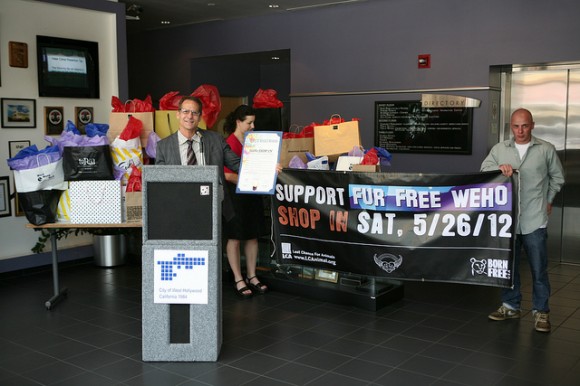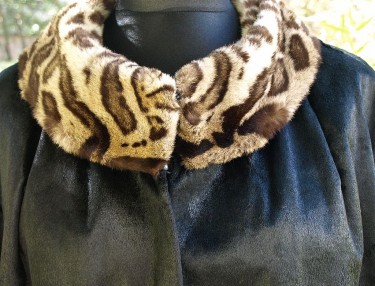
West Hollywood’s ban on clothing containing animal fur, set to go into effect Sept. 21, 2013, came under fire at Monday night’s City Council meeting after the city received an economic impact study about it effect.
The study, commissioned by the city when it passed the fur ban in November 2011, was due in May 2012, but was delayed when only a handful of businesses responded.
Of 257 apparel-related businesses contacted, 27 responded to the online survey about the ban’s impact. Of those 27 businesses, 16 said the ban would have a negative impact on them, although only 14 currently sell items that include fur. Five businesses said they were considering relocating out of the city because of the ban.

Conducted by Keyser Marston Associates, the report also said that the city would lose $28,000 in sales tax revenue by banning fur sales, approximately one percent of the $2.07 million in sales tax that apparel-related businesses in the city generate annually.
If the five businesses (not named, as the survey was confidential) do relocate, the report said the city would lose $42,000 in sales tax revenue. The report also concludes that if the five businesses leave, others businesses would likely come in to lease the retail spaces they now occupy.
Speaking during council’s public comment period, Genevieve Morrill, president of the West Hollywood Chamber of Commerce, said, “Even a single business closing is unacceptable in West Hollywood. Or one that won’t open.”
Keith Kaplan, head of the West Hollywood-based Fur Information Council of America (FICA), criticized the report for having such a small response rate.
“Retailers have told us repeatedly that they were afraid, they were intimidated, they felt it was a done deal and they chose not to respond,” Kaplan said.
Kaplan went on to point out that of the 27 businesses that did respond, 60 percent said it would have a negative impact on their businesses.
As for the small survey response, Councilmember John D’Amico, who sponsored the ban after championing the Fur Free cause during his election campaign in March 2011, told WEHOville: “If a renowned, trusted firm (like Keyser Marston) whose job it is to do economic surveys does not convince the community business leaders that they are reputable, then they are not convincible.”
As for the Chamber of Commerce’s continued opposition to the fur ban, D’Amico said, “Our Chamber of Commerce is sadly being dragged in the wrong direction by its member Keith Kaplan. I think that our Chamber used to be a reputable organization around many, many issues, but sadly they have lost their way on this issue.”
The numbers from the Keyser Marston report contrast with figures from an economic impact study that FICA commissioned last fall, prior to passage of the ban.
That FICA study, conducted by Horizon Consumer Science, surveyed 70 businesses and extrapolated the results across all clothing retailers in the city. The study found that of 209 apparel retailers in the city, 91 of them (46 percent) sold apparel containing fur. That report estimated the loss of sales tax revenue from fur sales would be $15,000 annually.
The discrepancy in the 209 apparel retailers in the FICA study vs. the 257 in the city study is because of different methodologies used to determine the number in the city. The FICA study used tax records from the California Board of Equalization. The city study used business license categories of “retail/wholesale sales,” “retail/wholesale sales clothing,” “retail/wholesale sales jewelry” and “retail/wholesale sales fabrics.”
Under the terms of the fur ban, sale of apparel with animal fur would be prohibited, but the sale of home furnishings with animal fur would not be banned. Apparel made of leather is not included in the ban.
“We oppose this arbitrary and capricious ban that was used as a symbolic and political statement on the backs of businesses,” Morrill said in her comments. “I implore you again to look at the strategic approach to this objective, something that is strong and concise, one that is a message that you desire without the sledgehammer, one that can be embraced by residents, businesses and visitors alike, and one that raises the consciousness in our society not by creating bans and legislation which dictate moral issues in a city that was built on diversity and spirit and freedom.”
Kaplan echoed Morrill’s sentiments, calling on the city to step back and reassess the ban.
“The study was requested to assess the economic implications of the proposed ban, and clearly it has not done that job,” Kaplan said.
Also during the public comment period, Fur Free West Hollywood advocate Ed Buck addressed Kaplan and Morrill’s comments.
“They arrived tonight screaming, ‘We’re afraid.’ There is nothing to be afraid of when you face the truth,” said Buck, a longtime resident. “The truth is most West Hollywood residents supported this ordinance. Fur-mageddon never happened. I have been unable to buy a beaver pelt at a Starbucks café. Yet the reputation of West Hollywood has been greatly enhanced.”
Included as part of the council’s consent calendar, the Keyser Marston report was intended to just be received and filed. No council discussion was scheduled about the report, and none of the councilmembers addressed it during their comments.
“The businesses that sell fur will stop selling fur. The businesses that refuse to stop selling fur may leave the city, but they will be replaced quite quickly with businesses that will not sell fur, and there will be less and less impact on the bottom line for the city budget,” D’Amico said.
